Around the world in 60 daysMal and Tracy's adventuresJapan; Tokyo, Kyoto, Fuji |
<<Australia<< | Index Click on an image to magnify it (JavaScript is required).
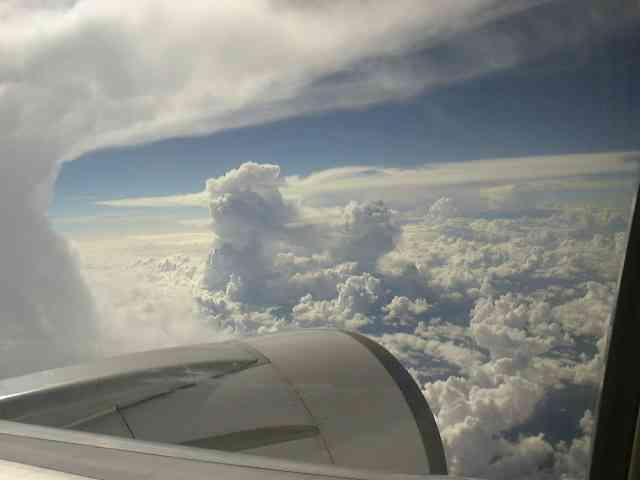 Japan is the most different
place we will be visiting this trip. So far all the places have been western in
nature. The first difficulty was finding money at the airport. Without it we
would be going nowhere. The first ATMs I found were either closed or took only
local credit cards. The man at the money changing office also did not take
credit cards but indicated where to find an ATM that did.
Japan is the most different
place we will be visiting this trip. So far all the places have been western in
nature. The first difficulty was finding money at the airport. Without it we
would be going nowhere. The first ATMs I found were either closed or took only
local credit cards. The man at the money changing office also did not take
credit cards but indicated where to find an ATM that did.
After that we managed to catch the last but one train for the 1.5 hour ride into Tokyo. By now it is 11 p.m. and our accommodation closes at 10:30 p.m. so we are getting a little worried as we still have to navigate the subway to Hongo-sanchome station. Fortunately for us most of the signs are repeated in English just below the Japanese characters. Out in the street, as we try to match Tracy's map with the one on the subway wall a Japanese girl tries to help us and we wait while she tries to work it out.
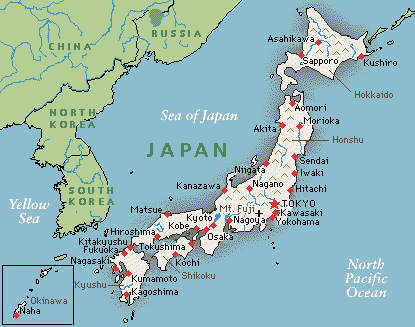 As we head down the main street wondering where our
left turn is some Swedish girls say they are going to the same Homeikan so we
follow them but it turns out it is the wrong place. The man there says he knows
where we want to go so grabs my rucksack and leads us away. I feel sorry for him
because it is quite heavy but he will not give it back. He leads us down tiny
paths between houses that are only just wide enough for a small car. Fortunately
he knows where he is going for we find a note taped to the front door of a
traditional style house with our name on it. They must be used to international
visitors for the sign is in English with floor maps and directions to our room.
As we head down the main street wondering where our
left turn is some Swedish girls say they are going to the same Homeikan so we
follow them but it turns out it is the wrong place. The man there says he knows
where we want to go so grabs my rucksack and leads us away. I feel sorry for him
because it is quite heavy but he will not give it back. He leads us down tiny
paths between houses that are only just wide enough for a small car. Fortunately
he knows where he is going for we find a note taped to the front door of a
traditional style house with our name on it. They must be used to international
visitors for the sign is in English with floor maps and directions to our room.
Inside the ornate sliding front doors the foyer floor is inlaid with black pebbles where we must change from outdoor shoes to indoor slippers. There are cubby holes with our name attached to on for our shoes. Two wooden steps lead up from here to the main entrance hall and steps up to the left. Everything is as you might expect to see a Japanese house from movies etc. There is polished wood everywhere with bamboo decoration. Even the floors upstairs are cross sections of tree trunks showing the grain and bark with black pebbles inlaid around.
Our room, named Sumire, has a glass panelled sliding door followed by an opaque panelled sliding door. In between is where we must remove our hallway slippers before entering the bedroom. The floor is covered with a reed mat (tatami). We have two comfy futons with bags of gravel for pillows. The walls are timber framed with brown coloured plaster in between and the roof is wood panelled with bamboo decoration. The window is shaded by rice paper held in wooden sliding frames. It was all very beautiful and we wanted to explore more but by this time it was about 1 am and all we could do was make some green tea in the service provided, eat the snack we picked up from a 24 hour noodle bar earlier and roll into bed. Once we discarded the gravel bags we got a good nights sleep.
The slipper thing has become more complicated. There are special slippers outside the toilet that you must change into as you enter the toilet and change back out of as you leave. There is a separate place to wash and brush your teeth and yet another place for a shower/bath.
The bathroom is large and as ornate as the rest of the building. We soon realise that it is supposed to be communal but as we are the only ones there we lock the door. Later on we find out that it is because the Japanese bathe in the evening, not in the morning. The changing room contains baskets for your clothes and beyond that is the bath room. This is a large room finished in marble with four shower points and a hot pool that a number of people can sit and relax in, so we do.
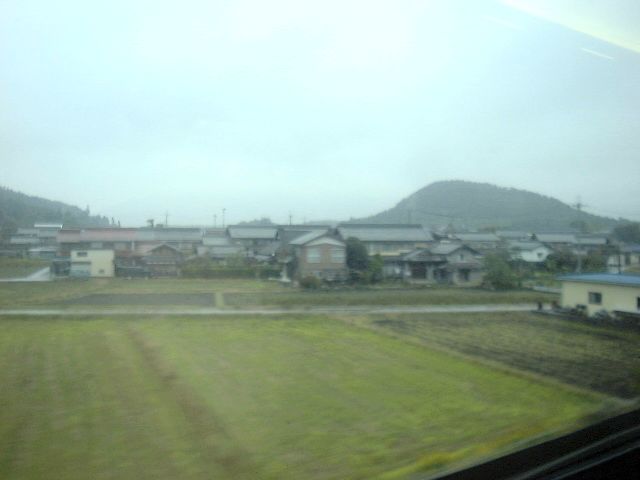
.jpg) Not surprisingly we are on
a tight schedule today with 230 miles to travel to Kyoto before lunch time so we
navigate our way down the tiny roads to a main road and come across a subway
station. A local helps us out with directions to the Shinkansen (bullet train).
This is an expensive way to go costing us £70 per ticket but will get us the
230 miles in about 2.5 hours. The ride is very smooth and comfortable but the
scenery goes past so fast you can hardly see anything. We will have to take the
slow train back even though it takes 6 hours.
Not surprisingly we are on
a tight schedule today with 230 miles to travel to Kyoto before lunch time so we
navigate our way down the tiny roads to a main road and come across a subway
station. A local helps us out with directions to the Shinkansen (bullet train).
This is an expensive way to go costing us £70 per ticket but will get us the
230 miles in about 2.5 hours. The ride is very smooth and comfortable but the
scenery goes past so fast you can hardly see anything. We will have to take the
slow train back even though it takes 6 hours.
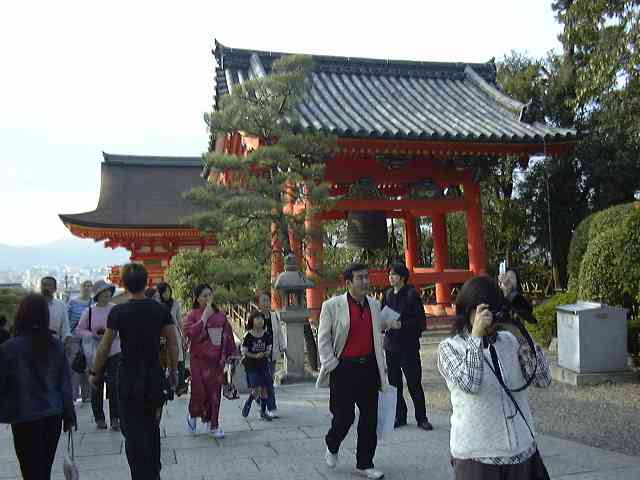
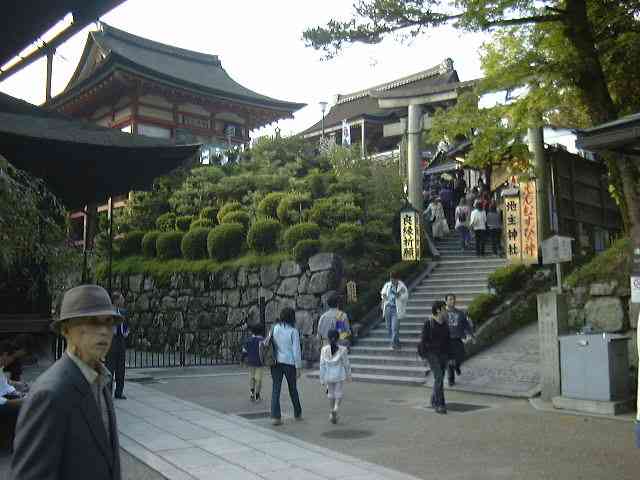 Our friend Mayumi meets us from the train and
introduces us to her father and college friend and her father drove us to a
Buddhist temple. This was one of those marvellously ornate places with gates and
temples and cultivated gardens all about. We stopped to watch people ring the
bell in front of Buddha to indicate their presence. make a prayer and leave a
coin for the maintenance of the temple. We queued up for a while to borrow a cup
with a very long handle which we then held out to catch and drink spring water
running off an overhanging roof built into the hillside. I am not sure of the
significance of this but we did it anyway.
Our friend Mayumi meets us from the train and
introduces us to her father and college friend and her father drove us to a
Buddhist temple. This was one of those marvellously ornate places with gates and
temples and cultivated gardens all about. We stopped to watch people ring the
bell in front of Buddha to indicate their presence. make a prayer and leave a
coin for the maintenance of the temple. We queued up for a while to borrow a cup
with a very long handle which we then held out to catch and drink spring water
running off an overhanging roof built into the hillside. I am not sure of the
significance of this but we did it anyway.
The walks were relaxing and the views out over Kyoto magnificent if misty.
After the temple, Mayumi and Akiko took us down through some of the market streets where we tasted Japanese sweets and tea. There were streets of shops selling sweets, china ware, antiques and arts. We walk on into the tourist part of town where Mayumi and Akiko introduced us to the photo booth craze where you take pictures of yourself and friends then decorate them with colourful backgrounds, icons and writing.
At 6:30 we arrive at a restaurant where we meet up with Mayumi's mother and father for dinner. We are served with alcoholic drinks made from sweet potato before the courses start arriving.
The first course is clear soup. Next comes a closed wooden box tied with coloured string containing three small dishes of exquisitely tasting foods including special vegetables from Kyoto, and duck with mustard. Next comes a bowl of clear soup containing vegetables and eel and large, sliced Japanese mushrooms. This is followed by a partitioned dish of three sushi including chicken, pork and smoked eel.
Mayumi's mother and father do not speak English and we do not speak Japanese so all through dinner Mayumi gets lots of practice translating between the two languages. The conversation is very slow and difficult but it is fun and interesting.
The next dish of green leaves, fine mushrooms and thinly sliced meat is laid in front of us but because we are carefully watching and following the protocol of our hosts we wait patiently. Shortly, further bowls of dark sauce centred by a small pile of grated Japanese radish appear but still we wait. Finally, individual stoves arrive but the saucepan is made of paper and contains boiling water with a little sauce. Following our hosts lead we take a slice of the meat and swish it in the boiling water for a minute before rolling it in the dark (soy and something, not Teriyaki but similar) sauce and radish before eating. The same goes for the green leafs and mushrooms.
By this time we are getting a little full up but along comes another course of steamed egg, the consistency of custard, containing vegetables, mushroom and seafood.
When we first arrived at the restaurant we thought this might be an expensive meal but by now we are certain we have blown our budget. Still, never mind, here comes another course; a bowl of rice topped with tiny fried fish and covered with green leaves (labiate) containing a tiny raw egg and accompanied by a bowl of miso soup.
About this time I notice Mayumi's father slide off to the bar and I start to worry that he is taking care of the bill. This makes me a little uncomfortable but Mayumi assures us that it is his way of thanking us for taking care of her so well on her trip to England (her words). Anyway, there is no time to think about that because along comes dessert; a bowl containing cubes of white tofu and sweet bean puree, a ball of apple sorbet with two wafer thin slices of apple and a red grape with its skin delicately cut and peeled halfway back then soaked in liqueur.
Finally, a cup of green tea to wash it all down.
I think that this is one of those few meals that I will remember forever. Not only for the exquisite food with its cacophony of flavours, all prepared and presented, but also for the view into the Japanese eating culture. We felt particularly honoured to be welcomed by the Morita family in this way.
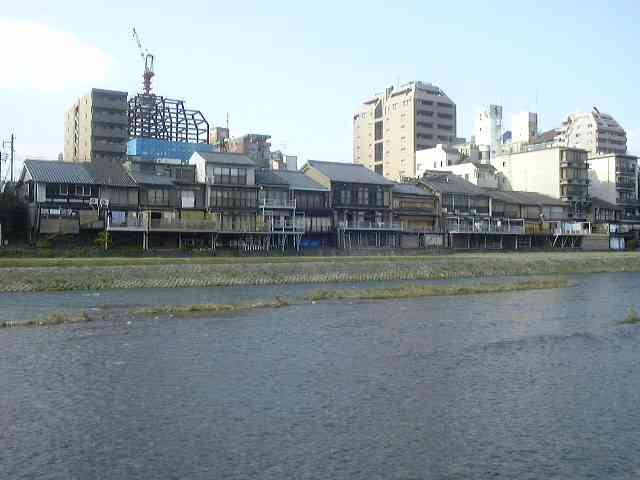 We made a slow start today having lunch at our
accommodation, Gojo Guest House before setting out. It is a pleasant, sunny day
so we decide to walk up the Kamo river to the Kyoto Imperial Park.
We made a slow start today having lunch at our
accommodation, Gojo Guest House before setting out. It is a pleasant, sunny day
so we decide to walk up the Kamo river to the Kyoto Imperial Park.
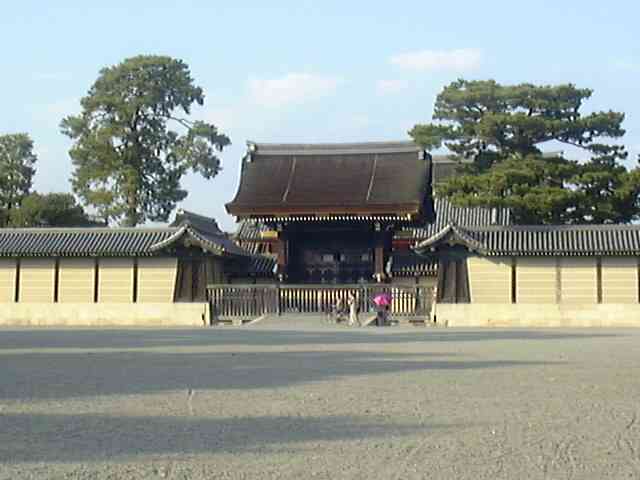 |
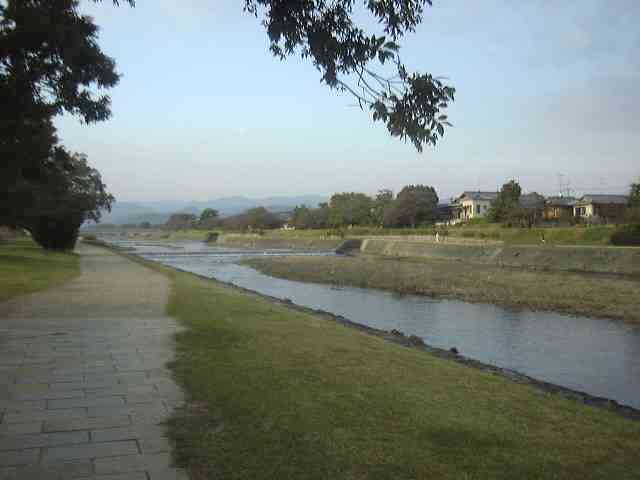 Further up the river we finally reach the Botanical
Gardens, only to see the gates closed as we approach. Darn it! We have no option
but to sit and watch the sun go down over the river.
Further up the river we finally reach the Botanical
Gardens, only to see the gates closed as we approach. Darn it! We have no option
but to sit and watch the sun go down over the river.
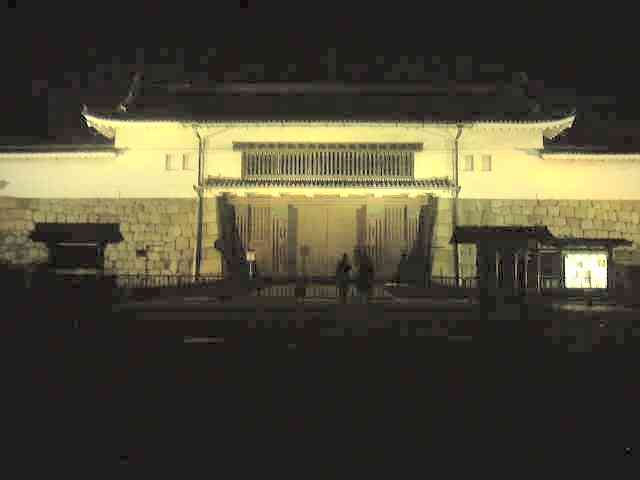 After another long walk, a cup of coffee at
Starbucks (they are getting everywhere these days, just like MacDonald's) and a
bus ride we reach Nijo Castle which Mayumi has told us looks good lit up at
night.
After another long walk, a cup of coffee at
Starbucks (they are getting everywhere these days, just like MacDonald's) and a
bus ride we reach Nijo Castle which Mayumi has told us looks good lit up at
night.
Mayumi came out to meet us at 8 p.m.. We had wanted to experience a traditional Japanese tea ceremony but all the right places were closed so we went to Starbucks instead. This seems like a bit of a let down but they did have Matcha which is a bitter green tea used in the tea ceremony, even if it was in 'frappacino' style and there was no ceremony. Still, we spent a lovely couple of hours chatting with Mayumi on the patio outside.
We all walked to the river together where we go our separate ways. It seems a very safe and comfortable city to walk around at night. There are not so many cars especially on the small streets and even then the drivers give way to pedestrians. There are more bicycles than cars and the cyclists weave carefully between the pedestrians on the pavement and small roads.
It rained all night which does not bode well for our trip to see Mount Fuji today. A short bus ride takes us to Kyoto train station but it all looks different from when we were here two days ago so we take a while to find the Shinkansen (Bullet) train. At the ticket office the tickets are more expensive than we thought (Yen 20560 for 2 = £112) but it takes less time to get to Mishima station near Mount Fuji so we buy them anyway. Outside we find a ticket machine that seems to sell the same ticket for Yen 6000 each, rats!
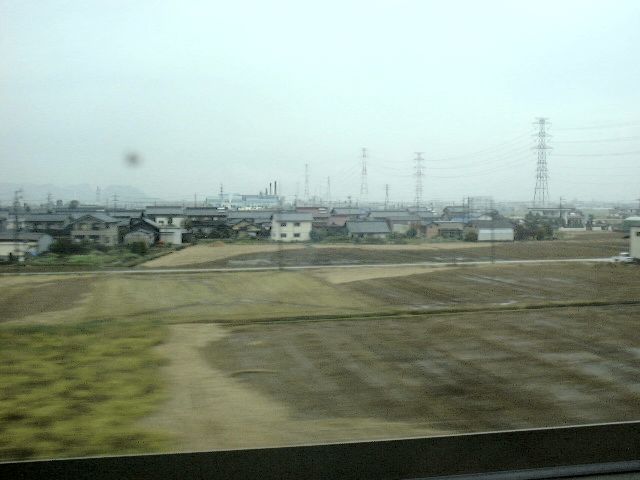 The Shinkansen zips through the country at a blurry
kind of speed. There seems to be no time that you cannot see houses out of the
window and normally you can see lots. There are patches of fields but they are
small and surrounded by factories and houses. Far away from the cities the
houses have more character, are a little bigger and have some space around them.
It is quite a contrast from Australia where there are no space or population
problems.
The Shinkansen zips through the country at a blurry
kind of speed. There seems to be no time that you cannot see houses out of the
window and normally you can see lots. There are patches of fields but they are
small and surrounded by factories and houses. Far away from the cities the
houses have more character, are a little bigger and have some space around them.
It is quite a contrast from Australia where there are no space or population
problems.
In Mishima we have to catch a bus to Kawaguchi-ko near Mount. Fuji. Again we are approached by a man offering help and it is fortunate that he does because it would have been difficult to find the right bus station let alone the right stop and bus. It turns out that we need to take two busses to get there and fortunately we change to the second bus at the terminal point of the first bus so we do not have to try to work out where we are and where to get off. The luxury of English translations of place names was confined to the city centres so out here we have to try and work out where we are using the Japanese characters, something I have not yet been successful at.
Quite surprisingly we arrive at Kawaguchi without a hitch and even manage to call 'Hotel Sunnide Village' for the free ride to our accommodation for the night. Hotel Sunnide is in the banks of Lake Kawaguchi with a view of Kawaguchi town and Mount Fuji. Unfortunately it is still raining and cloudy so we cannot see Mount Fuji but the lake looks very pretty.
Although Hotel Sunnide is modern, the evening meal is traditional Japanese so we treat ourselves to a small one. This time though, everything comes at once and we are left without a guide to help us navigate the meal properly.
We have one of the only two rooms in the hotel that are not decorated in traditional Japanese style which is a shame. The bed is western style but the pillow this time is a big bag of sawdust. Interestingly though, if you turn the pillow over it is soft and comfortable.
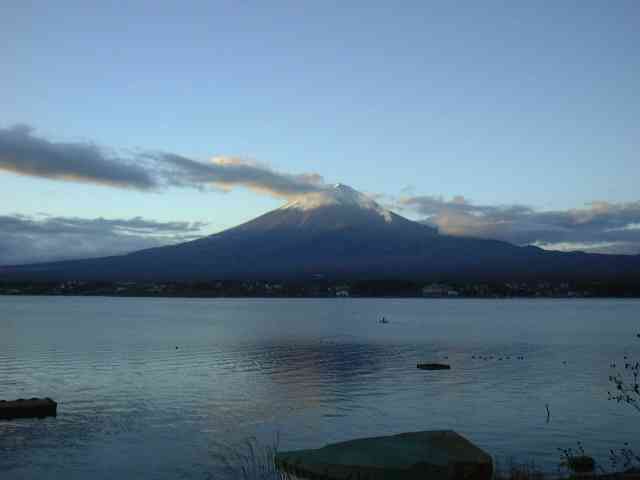 The weather forecast is
cloudy so we set the alarm for 6 am in the hope that there will be no clouds at
sunrise. Yippee! there are only a few clouds and we can see the snow covered
peak across the lake with the first rays of sunlight lighting it up.
The weather forecast is
cloudy so we set the alarm for 6 am in the hope that there will be no clouds at
sunrise. Yippee! there are only a few clouds and we can see the snow covered
peak across the lake with the first rays of sunlight lighting it up.
As forecast the clouds roll in and cover the whole mountain as if it was not even there so we decide to walk around Lake Kawaguchi.
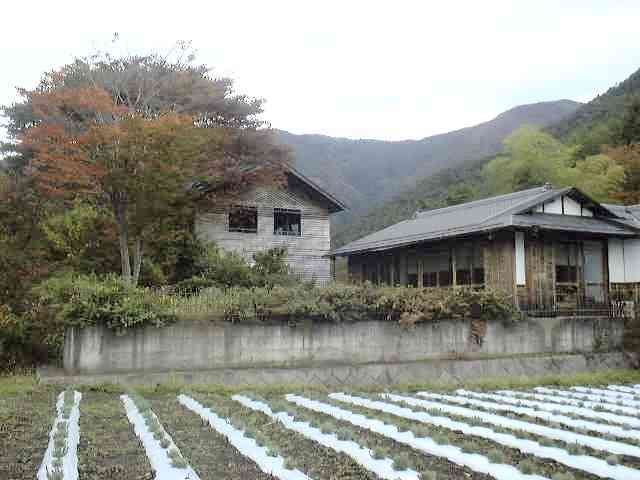 |
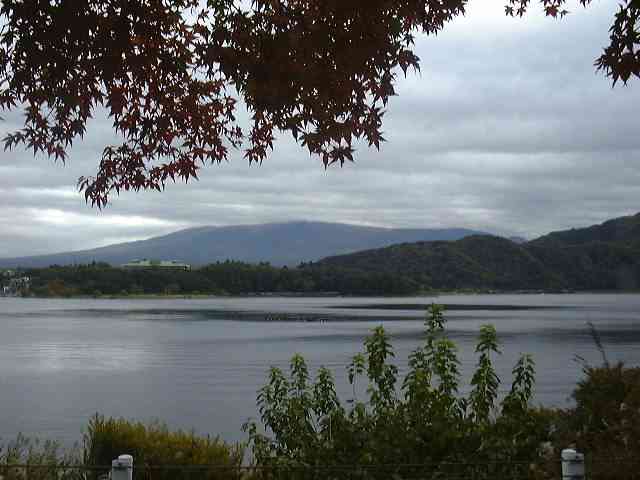 Fishing seems to be very popular here both from the
banks and from rowing boats on the lake. Further across there are people
water-skiing and wake-boarding despite the cold.
Fishing seems to be very popular here both from the
banks and from rowing boats on the lake. Further across there are people
water-skiing and wake-boarding despite the cold.
As we walk around a headland another big stretch of lake comes into view and we wonder if we can walk it all in a day but we boldly march on regardless.
We pass through a couple of towns but most of the shops and cafes seem to be closed, probably because it is now out of season. It is a shame because we could do with a hot drink by now.
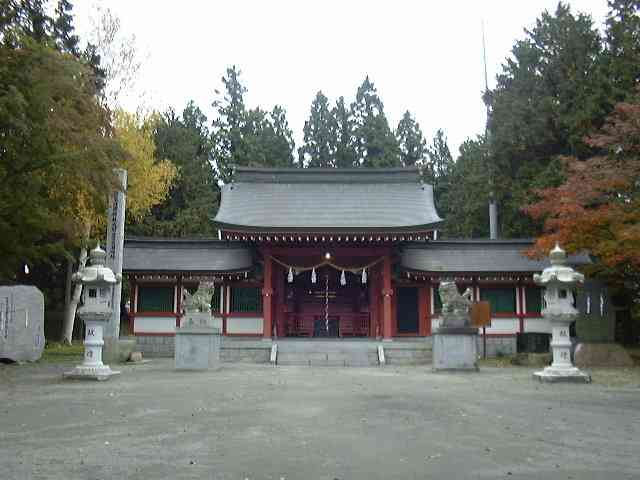 We stopped at a shrine to the goddess of cherry
blossom and the sign outside said that this was the origin of archery on
horseback. That would explain the street lamps with hats and holding bows and
arrows.
We stopped at a shrine to the goddess of cherry
blossom and the sign outside said that this was the origin of archery on
horseback. That would explain the street lamps with hats and holding bows and
arrows.
My camera took a turn here making me think that I had lost the 300 or so pictures I had taken over the last two months. Fortunately, after a couple of resets it started reading the memory card again.
We just about made it back to the hotel before dinner figuring that we had walked about 10-15 miles round the lake. After our Japanese meal we treated ourselves to a bottle of beer each.
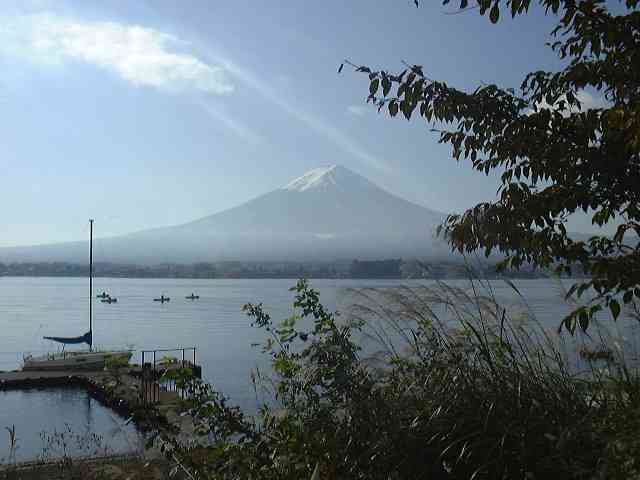 Neither the local bus nor the tourist bus left the
Hotel at the right time to get us to Kawaguchi bus station for the early bus to
Tokyo so we had to settle for the later hotel courtesy bus and catch the 10:59.
Neither the local bus nor the tourist bus left the
Hotel at the right time to get us to Kawaguchi bus station for the early bus to
Tokyo so we had to settle for the later hotel courtesy bus and catch the 10:59.
The sun came out today and the scenery was wonderful in the crisp mountain air. Mount Fuji was clearly visible in all its perfect volcano shape. It is a shame it was not like this yesterday.
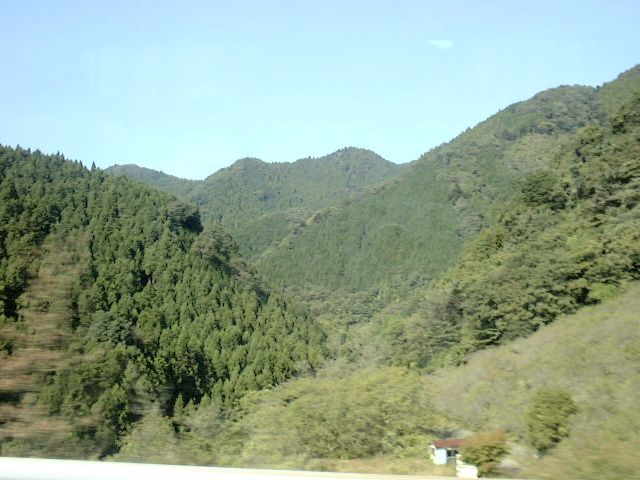 Even before we are down from the mountains the urban
sprawl begins again, stretching for as far as the eye can see. The houses are
packed so close that there is often only space for a footpath in between and no
garden at all. Roads between the houses are only wide enough for one car. I can
imagine it would be quite depressing to live so closely packed together with no
green space to relax in. There is so little room left in Japan even the cows
live in high-rise apartments.
Even before we are down from the mountains the urban
sprawl begins again, stretching for as far as the eye can see. The houses are
packed so close that there is often only space for a footpath in between and no
garden at all. Roads between the houses are only wide enough for one car. I can
imagine it would be quite depressing to live so closely packed together with no
green space to relax in. There is so little room left in Japan even the cows
live in high-rise apartments.
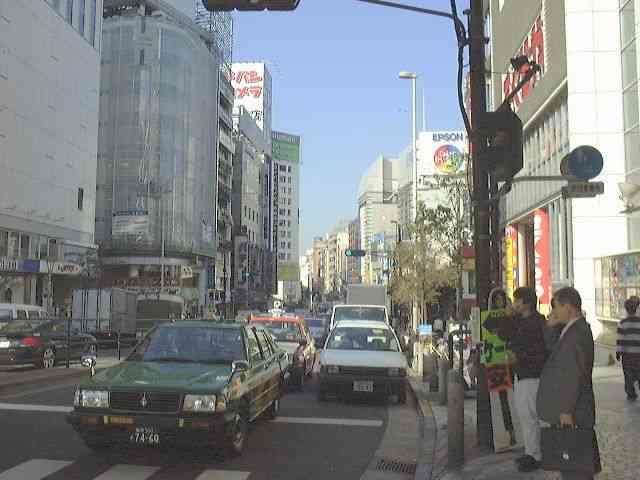 The bus dropped us at Shinjuko station, one of
Tokyo's major transportation centres where 3 million people travel through each
day. We stop to watch a few hundred thousand of them while sipping a cup of
coffee.
The bus dropped us at Shinjuko station, one of
Tokyo's major transportation centres where 3 million people travel through each
day. We stop to watch a few hundred thousand of them while sipping a cup of
coffee.
After that we hop on the subway round to Tokyo station where we squeeze our
rucksacks into lockers slightly too small for them and trek off to the Imperial
Palace. 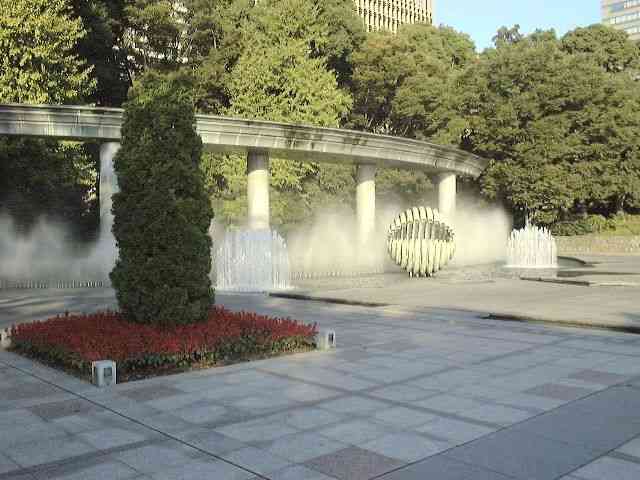 Before we even get there we are captivated by the
fountains in the Wadakura Fountain Park. But finally we cross the road, past the
Kikyomon Gate and into the Kokyogaien National Garden which seems to be covered
with a bunch of dwarf pine trees.
Before we even get there we are captivated by the
fountains in the Wadakura Fountain Park. But finally we cross the road, past the
Kikyomon Gate and into the Kokyogaien National Garden which seems to be covered
with a bunch of dwarf pine trees.
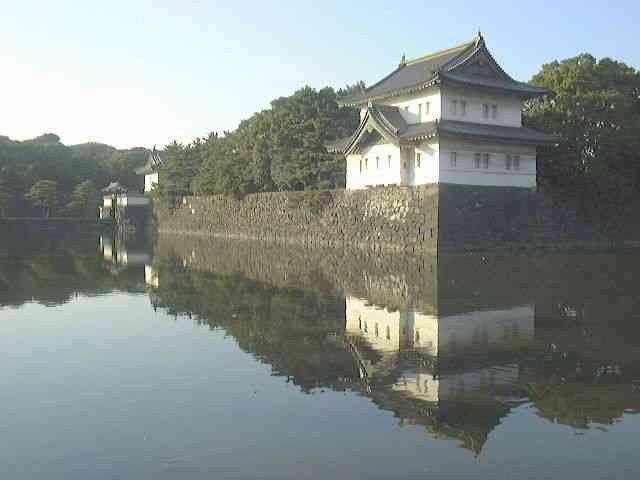 Even though the grounds are surrounded by a very
wide moat, the palace itself is surrounded by a second moat occasionally
breached by a bridge such as the Nijubashi Bridge. That seems to be all there is
to the Palace except for the East Garden which is right round the other side so
we nip into the Hibiya Park just across the road. This is a bit better with a
few traditional Japanese gardens mixed in with a Rose garden and other European
style gardens.
Even though the grounds are surrounded by a very
wide moat, the palace itself is surrounded by a second moat occasionally
breached by a bridge such as the Nijubashi Bridge. That seems to be all there is
to the Palace except for the East Garden which is right round the other side so
we nip into the Hibiya Park just across the road. This is a bit better with a
few traditional Japanese gardens mixed in with a Rose garden and other European
style gardens.
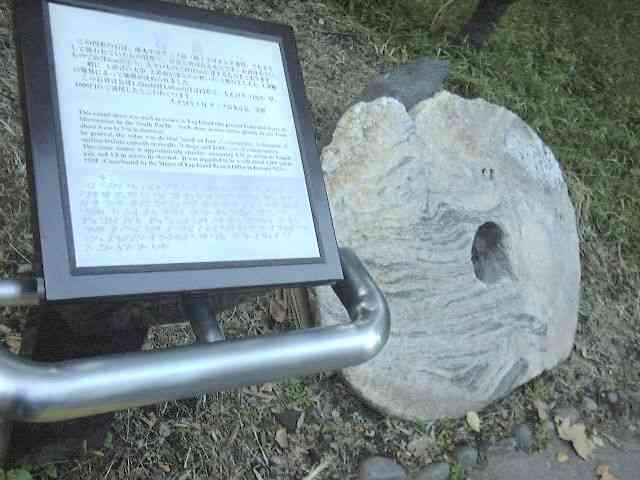 Beside one of the paths there is an example of Yap
Island (Federated States of Micronesia, south Pacific) money. This is a large
flat stone about a meter in diameter with a hole in the middle. Worth about Yen
1000 (£5). I kid
you not!
Beside one of the paths there is an example of Yap
Island (Federated States of Micronesia, south Pacific) money. This is a large
flat stone about a meter in diameter with a hole in the middle. Worth about Yen
1000 (£5). I kid
you not!
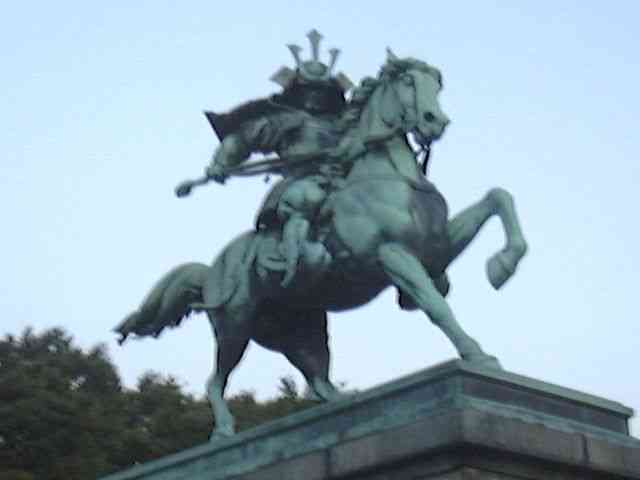 On the way back to see the Palace East Garden we
happen upon the statue of Kusunoki Masashige. He must of died with his boots of
for his horse only has one hoof raised (UK military statue interpretation
states: the more hoofs raised the more glorious his demise. I have yet to see
all 4 hoofs raised).
On the way back to see the Palace East Garden we
happen upon the statue of Kusunoki Masashige. He must of died with his boots of
for his horse only has one hoof raised (UK military statue interpretation
states: the more hoofs raised the more glorious his demise. I have yet to see
all 4 hoofs raised).
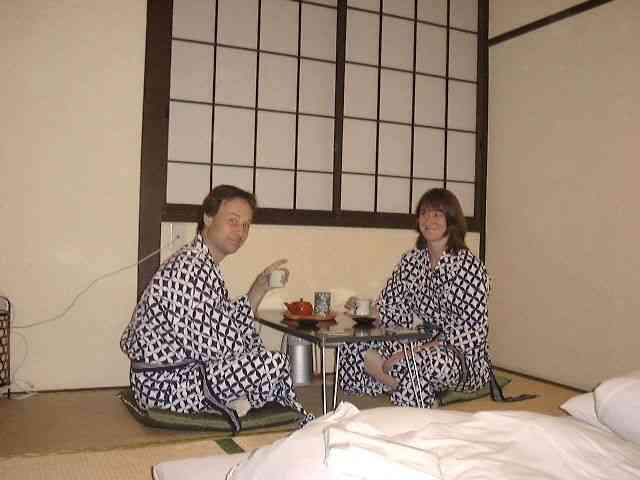 By the time we reach the Palace East Garden they
have closed the gates for the night so we head back to the station to pick up
our bags and navigate to our accommodation for the night. It is always a bit
scary trying to navigate around in a foreign country but when all the signs are
unreadable it becomes a bit bewildering. Standing about with a map in your hand
By the time we reach the Palace East Garden they
have closed the gates for the night so we head back to the station to pick up
our bags and navigate to our accommodation for the night. It is always a bit
scary trying to navigate around in a foreign country but when all the signs are
unreadable it becomes a bit bewildering. Standing about with a map in your hand
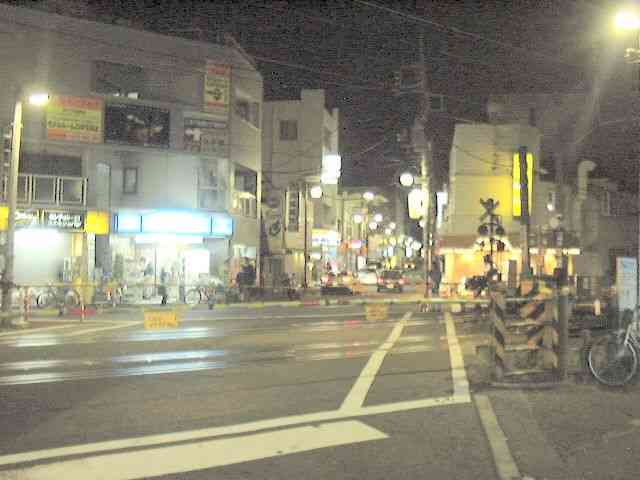 |
This time we have a chance to savour the traditional room and partake in our own little tea ceremony.
The narrow streets outside are packed with eateries and we soon find the little noodle bar out of our imaginations. One of the chefs comes outside so that I can point to our choice of dishes in the display of plastic imitations outside. The real thing turns out to look just the same but tastes real good.
Well, this is our last day in Japan and the last day of our trip. All we have to do is get to the airport in time, which is no problem.